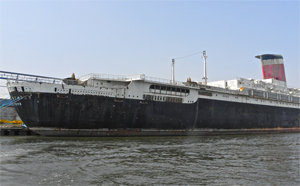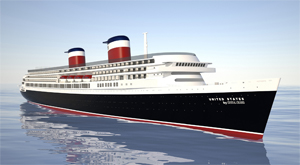A cruise ship line may throw a life preserver to the iconic ocean liner SS United States to save it from the scrap yard.
The decades-long effort by preservationists to save the 64-year-old vessel that still holds the trans-Atlantic speed record may have paid off with the announcement in February that Crystal Cruises is studying the feasibility of refitting “America’s flagship” and returning it to sea.
SS United States Conservancy, the nonprofit organization that owns the ship, and the Los Angeles-based luxury cruise line said the ship could be purchased and retrofitted if a feasibility study provides positive results. The announcement came as a surprise. The conservancy has been focused in the past few years on trying to return the 990-foot ship, now mothballed in Philadelphia, to New York for a new life as a stationary attraction. But finding a developer willing to do that and a permanent site for the ship proved frustrating.
Susan Gibbs, the conservancy’s executive director and granddaughter of ship designer William Francis Gibbs, said the ship will return to New York “but New Yorkers will have to share her with the rest of the world.” Crystal plans to return the ship to trans-Atlantic service and have it make other cruises from the city and other American ports.
“We would be remiss if we would pass up an opportunity to restore such an important symbol of luxury travel and a bygone era of Americana,” Crystal Chief Executive Edie Rodriguez said at a Feb. 4 news conference at the Manhattan Cruise Terminal at Pier 88, just up the Hudson River from where United States used to dock at Pier 86.
The company will pay the $60,000-per-month carrying charges to keep the ship docked in Philadelphia during the feasibility study, which will be led by retired U.S. Coast Guard Rear Adm. Tim Sullivan. Rodriguez expects a determination by the end of the year.
Crystal would reconfigure United States to add balconies along its sides. Artist renderings depict a more boxy look than its classic rakish appearance, but Gibbs said, “We think this is the best way to save the ship. The essence of her will remain front and center.”
Rodriguez said rebuilding the gutted vessel would cost in excess of $700 million, potentially cheaper than building a similar ship from the keel up.
“Failure is not an option,” said Rodriguez, who added that the only thing that would stop the project is if the Environmental Protection Agency said contaminants could not be remediated.
Robert Sturm, an 81-year-old Long Island, N.Y., resident who served as a junior engineering officer aboard the “Big U” for 44 voyages between 1957 and 1959, said the ship “was the epitome of trans-Atlantic steamship design. It was a magnificent example of American naval architecture and marine engineering, ship construction and operation.”
Sturm, who attended the news conference and is writing a book about the ship and his experience on board, said of the Crystal plan: “They’re looking to create a luxury vehicle for high-end passengers, with larger-than-typical cabins. If the market is there, it will succeed. I’m happy that they’re keeping the general silhouette of the ship.”
One industry expert greeted the announcement with skepticism. Oivind Mathisen, editor and publisher of Cruise Industry News magazine, called Crystal’s plans “more of a publicity effort” than a realistic project.
 |
|
The nation’s flagship ocean liner floats dormant at a Philadelphia dock in 2014. The vessel has remained tied up there for the past 20 years. |
|
Will Van Dorp |
“Many people have tried this before,” he said. “We’re talking about a ship that is 64 years old and it’s been sitting there since the late 1960s. They talk about a price of $750 million. For that money they could build a brand new SS United States and not have to deal with all the old stuff. I don’t think it’s very viable from a business point of view.”
He said the layout of the interior bulkheads in the ship, even though it has been gutted, does not lend itself to modern cruise ship design.
There may be, to some extent, a demand from potential passengers interested in traveling on the historic vessel, according to Mathisen. “But I don’t think it’s enough to warrant what they’re doing. What would make sense would be to redo her and tie her up in New York as a hotel ship.”
Rodriguez said the ship would have a crew of more than 600. It has not been determined where it would be registered, where the retrofitting would be done or how the project would be financed. She hopes to have the ship operating in 2018.
If Crystal buys the ship, it would be the fourth oceangoing vessel for the company. United States, launched in 1952, originally carried 2,000 passengers. It would be transformed into an 800-guest vessel with 400 luxury suites each measuring about 350 square feet. Original features, including the Promenade Deck and Navajo Lounge, would be retained.
If the renovation goes forward, Gibbs said the conservancy would focus on building a museum ashore, ideally in New York City.
United States, its role superseded by passenger jets, was taken out of service in 1969. The rusting ship, larger than Titanic, has been moored in Philadelphia for nearly two decades. The vessel was stripped of its interior in 1984.
Last October, the conservancy’s board announced that it was seeking bids to sell the ship for scrap. That brought in $600,000 in donations to buy time.
When it was taken out of service, United States remained part of the U.S. Navy’s reserve fleet until 1978, when the Navy decided to sell the ship. Since then, United States has passed from owner to owner.
Royal Caribbean Cruises Ltd. looked at restoring the ship in the early 1990s but decided its shape, as it was designed for speed, and other issues ruled out the project. Norwegian Cruise Lines (NCL) acquired the ship in 2003, but plans to refurbish it fell through. Norwegian was owned at the time by Genting Hong Kong, which last year bought Crystal.
In 2009, NCL began looking for buyers for United States, but when the company failed to receive any offers it began looking toward scrapping the ship. That prompted the SS United States Conservancy to launch its campaign. In 2010, the conservancy announced that it had received a grant from Philadelphia philanthropist H.F. “Gerry” Lenfest enabling the purchase of the ship.

